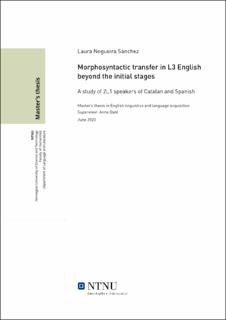| dc.description.abstract | This study investigates morphosyntactic transfer in the acquisition of English as an L3 by bilingual (2L1) speakers of Catalan and Spanish. Several previous L3A studies have focused on the same population, but most have only recruited participants in the initial stages of L3A, whereas this thesis concentrates specifically on how previously acquired languages can influence the L3 beyond the initial stages. Additionally, this thesis also examines two groups of morphosyntactic properties which have not been studied before in this population: (1) locative, projective, spatial prepositions (LPSPs) followed by a pronoun and (2) hodiernal structures. Causative structures, which one study of the initial stages had previously examined, are also included in this thesis. The main aim of the present study is to establish whether only one or both of the previously learned languages can influence the L3. Since previous studies have only found evidence of transfer from Catalan, the main hypothesis of the present study is that transfer from Catalan in the aforementioned properties can be detected beyond the initial stages, especially among participants who are less proficient in English.
Three groups of participants took part in the study: L3 learners of English who were 2L1 speakers of Catalan and Spanish, L2 learners of English who were L1 speakers of Spanish, and L1 speakers of English (who acted as a control group). The L3 and L2 groups were divided into smaller subgroups according to their English proficiency. All groups completed an acceptability judgment task (AJT) in English and a background questionnaire. Additionally, the L3 and L2 groups were asked to complete AJTs in their respective L1s.
Though the results showed evidence of transfer, establishing the source of transfer was impossible in most cases except one: there was evidence of transfer from Spanish in one of the LPSP conditions, which we call of+obq (*behind of me). Additionally, the results of the present study, in combination with those of Puig-Mayenco & Marsden (2018), suggest that transfer from both Catalan and Spanish is possible in L3A beyond the initial stages of acquisition, as posited by the Linguistic Proximity Model (Westergaard et al., 2017) and the scalpel model (Slabakova, 2017). Furthermore, since one condition which was expected to be unacceptable in Spanish turned out to be acceptable in the Spanish grammar of the L3 group, the present study highlights the importance of testing the properties of the learners’ prior languages in L3 research. | |
